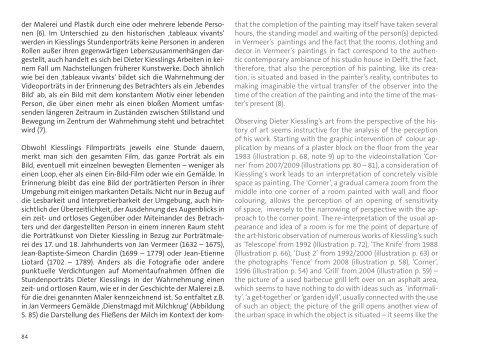DIETER KIESSLING - home
DIETER KIESSLING - home
DIETER KIESSLING - home
Erfolgreiche ePaper selbst erstellen
Machen Sie aus Ihren PDF Publikationen ein blätterbares Flipbook mit unserer einzigartigen Google optimierten e-Paper Software.
der Malerei und Plastik durch eine oder mehrere lebende Personen<br />
(6). Im Unterschied zu den historischen ‚tableaux vivants‘<br />
werden in Kiesslings Stundenporträts keine Personen in anderen<br />
Rollen außer ihren gegenwärtigen Lebenszusammenhängen dargestellt,<br />
auch handelt es sich bei Dieter Kiesslings Arbeiten in keinem<br />
Fall um Nachstellungen früherer Kunstwerke. Doch ähnlich<br />
wie bei den ‚tableaux vivants‘ bildet sich die Wahrnehmung der<br />
Videoporträts in der Erinnerung des Betrachters als ein ‚lebendes<br />
Bild‘ ab, als ein Bild mit dem konstantem Motiv einer lebenden<br />
Person, die über einen mehr als einen bloßen Moment umfassenden<br />
längeren Zeitraum in Zuständen zwischen Stillstand und<br />
Bewegung im Zentrum der Wahrnehmung steht und betrachtet<br />
wird (7).<br />
Obwohl Kiesslings Filmporträts jeweils eine Stunde dauern,<br />
merkt man sich den gesamten Film, das ganze Porträt als ein<br />
Bild, eventuell mit einzelnen bewegten Elementen – weniger als<br />
einen Loop, eher als einen Ein-Bild-Film oder wie ein Gemälde. In<br />
Erinnerung bleibt das eine Bild der porträtierten Person in ihrer<br />
Umgebung mit einigen markanten Details. Nicht nur in Bezug auf<br />
die Lesbarkeit und Interpretierbarkeit der Umgebung, auch hinsichtlich<br />
der Überzeitlichkeit, der Ausdehnung des Augenblicks in<br />
ein zeit- und ortloses Gegenüber oder Miteinander des Betrachters<br />
und der dargestellten Person in einem inneren Raum steht<br />
die Porträtkunst von Dieter Kiessling in Bezug zur Porträtmalerei<br />
des 17. und 18. Jahrhunderts von Jan Vermeer (1632 – 1675),<br />
Jean-Baptiste-Simeon Chardin (1699 – 1779) oder Jean-Etienne<br />
Liotard (1702 – 1789). Anders als die Fotografie oder andere<br />
punktuelle Verdichtungen auf Momentaufnahmen öffnen die<br />
Stundenporträts Dieter Kiesslings in der Wahrnehmung einen<br />
zeit- und ortlosen Raum, wie er in der Geschichte der Malerei z.B.<br />
für die drei genannten Maler kennzeichnend ist. So entfaltet z.B.<br />
in Jan Vermeers Gemälde ‚Dienstmagd mit Milchkrug‘ (Abbildung<br />
S. 85) die Darstellung des Fließens der Milch im Kontext der kom-<br />
84<br />
that the completion of the painting may itself have taken several<br />
hours, the standing model and waiting of the person(s) depicted<br />
in Vermeer’s paintings and the fact that the rooms, clothing and<br />
decor in Vermeer’s paintings in fact correspond to the authentic<br />
contemporary ambiance of his studio house in Delft, the fact,<br />
therefore, that also the perception of his painting, like its creation,<br />
is situated and based in the painter’s reality, contributes to<br />
making imaginable the virtual transfer of the observer into the<br />
time of the creation of the painting and into the time of the master’s<br />
present (8).<br />
Observing Dieter Kiessling’s art from the perspective of the history<br />
of art seems instructive for the analysis of the perception<br />
of his work. Starting with the graphic intervention of colour application<br />
by means of a plaster block on the floor from the year<br />
1983 (illustration p. 68, note 9) up to the videoinstallation ‘Corner’<br />
from 2007/2009 (illustrations pp. 80 – 81), a consideration of<br />
Kiessling’s work leads to an interpretation of concretely visible<br />
space as painting. The ‘Corner’, a gradual camera zoom from the<br />
middle into one corner of a room painted with wall and floor<br />
colouring, allows the perception of an opening of sensitivity<br />
of space, inversely to the narrowing of perspective with the approach<br />
to the corner point. The re-interpretation of the usual appearance<br />
and idea of a room is for me the point of departure of<br />
the art-historic observation of numerous works of Kiessling’s such<br />
as ‘Telescope’ from 1992 (Illustration p. 72), ‘The Knife’ from 1988<br />
(illustration p. 66), ‘Dust 2’ from 1992/2000 (illustration p. 63) or<br />
the photographs ‘Fence’ from 2008 (illustration p. 58), ‘Corner’,<br />
1996 (illustration p. 54) and ‘Grill’ from 2004 (illustration p. 59) –<br />
the picture of a used barbecue grill left over on an asphalt area,<br />
which seems to have nothing to do with ideas such as ‘informality’,<br />
‘a get-together’ or ‘garden idyll’, usually connected with the use<br />
of such an object; the picture of the grill opens another view of<br />
the urban space in which the object is situated – it seems like the


